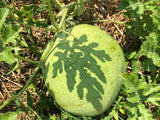Odell's Large White Watermelon
Citrullus lanatus
Odell's Large White Watermelon fruits are gigantic with sweet, pink, juicy flesh, light green skin, and white seeds (though not very many). The rinds are tender, almost as sweet as the flesh, and great for pickling.
While watermelons were first domesticated in Africa, this is one of few that are known to be a variety connected to a particular African American person, who in this case is an unnamed man who selected this variety during or before the 1840s on a plantation in Pomaria, SC. Our original seed came from Southern Exposure Seed Exchange. Theirs came from Rodger Winn whose wife Karen Metzes's family has stewarded this melon since 1880. Our coworker Amirah Mitchell advocated for us to include this variety at our farm this year.
Amirah will be growing this variety for our catalog at her new farm project, Sistah Seeds, among dozens of other seed crops important to Africans and African Americans in the diaspora.
This is a protected variety by the Slow Food Ark of Taste.
Also known as White Stoney Mountain Watermelon.
Days to maturity: 90
Seeds per pack: 40-45
Germination rate: 95% on 10/31/2025
Planting / harvesting notes
Direct sow in warm soil after the last frost, or seed indoors 3-4 weeks beforehand and transplant. Space 12-18" apart in rows that are 6-8' apart. Keep ground slightly moist until germination, but do not overwater. Watermelons love heat and well drained soils.
Seed keeping notes
Watermelons are insect pollinated and need 1/2 mile between different varieties of C. lanatus to prevent unwanted cross-pollination. It is difficult to know when a watermelon is truly ripe. In Seed to Seed by Suzanne Ashworth, she recommends waiting until the small tendril opposite the melon's "peduncle" (stem attachment) changes from green to brown and dries out. You can also look for color changes in the skin, and listen for a thud when the fruit is tapped. Seeds are ready for harvest when the melon is ready to eat. Dry them out in a ventilated place away from direct sunlight.













